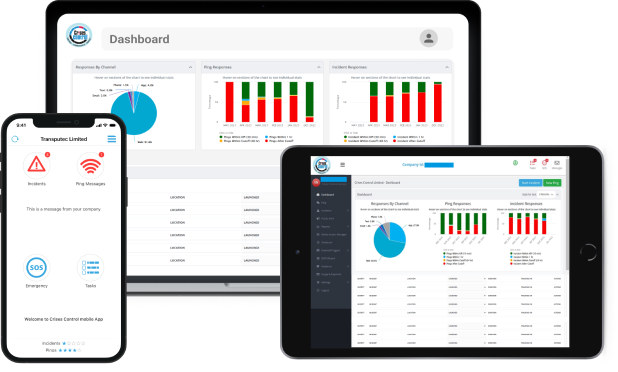Written by Anneri Fourie | Crises Control Executive
A service outage. A data breach. A system failure during market hours. When these incidents happen in a financial institution, the impact can be immediate and far-reaching. Customers lose trust, regulators start asking questions, and the pressure to respond is intense.
Yet many financial organisations still rely on static documents and outdated procedures that are hard to access and even harder to action in a real emergency.
This article outlines how to build crisis management plans that work when it counts. We will look at what makes these plans truly effective for financial institutions and how technology, such as Crises Control, can help turn them into an operational asset rather than just a compliance exercise.
Why Financial Institutions Cannot Rely on Traditional Plans
Financial institutions operate in one of the most tightly regulated and complex environments of any sector. Delays in response or communication can trigger regulatory breaches, legal action, or significant financial loss.
Despite this, many crisis plans are:
- Designed to meet audit requirements but lack practical usability
- Rarely tested under real-world conditions
- Unclear about who should do what and when
- Stored in locations or formats that are inaccessible in a crisis
Crisis management plans must do more than tick boxes. They need to guide action under pressure, support regulatory expectations, and enable teams to respond quickly, consistently, and with confidence.
Developing Crisis Management Plans for Financial Institutions: The Core Components
An effective crisis plan for a financial institution must reflect the reality of operations, technology, regulation, and reputational risk. Below are the key components to get right.
1. Identify Critical Risks with a Live Business Impact Analysis
A spreadsheet of theoretical risks will not help when a core trading platform fails. You need a current, practical view of which services and processes are essential.
A strong Business Impact Analysis (BIA) will:
- Map out dependencies between systems, teams, and third parties
- Highlight critical business processes and the consequences of failure
- Define maximum acceptable downtimes and required recovery speeds
- Identify regulatory touchpoints that must be considered in a response
Make the BIA a living part of your resilience strategy. If your infrastructure changes, the BIA should be updated. Otherwise, your crisis plan will be based on old assumptions.
2. Define Roles and Escalation Paths Clearly
In a crisis, time is lost when people are unsure what to do or who has the authority to act. Your plan must spell out exactly who is responsible for what.
Each person involved in the response should know:
- Their individual responsibilities
- The team or department they report to
- What decisions they can make independently
- When and how to escalate an issue
Avoid lengthy chains of approval. Empower those on the front line to take action quickly, especially during the first half hour of an incident when speed matters most.
3. Build Communication into the Plan, Not Around It
Communication failures are one of the most common breakdowns during a crisis. Messages are delayed, inconsistent, or fail to reach the right people. This causes confusion and can make a situation worse.
A strong communication plan should include:
- Pre-written, approved message templates for staff, customers, regulators, and partners
- Multiple channels to reach people including SMS, voice calls, mobile apps, and email
- A way to confirm that critical messages have been received and understood
- The ability to operate even if the main network or email system is down
Crisis management software like Crises Control plays a crucial role here by making it easy to send urgent messages instantly, track acknowledgements, and ensure no one is left out of the loop.
4. Meet Regulatory and Audit Requirements Automatically
In financial services, responding quickly is not enough. You must be able to prove that you acted in line with your policies and that the actions taken were appropriate.
Crisis management plans must align with key frameworks and regulations, including:
- ISO 22301 (Business Continuity Management)
- DORA (Digital Operational Resilience Act) for EU-based institutions
- FFIEC guidelines for US institutions
- Local and cross-border data protection laws
Crises Control helps meet these requirements by keeping a complete, time-stamped record of all actions taken during an incident. This makes it easier to demonstrate compliance during audits and investigations.
5. Test Your Plan Under Real Conditions
A crisis plan that is never tested will almost always fail when it is needed. Real testing reveals issues that are not obvious on paper.
Effective testing should include:
- Simulated cyberattacks or data breaches
- Testing response capability during non-office hours or remote working scenarios
- Involving third-party service providers who are part of critical workflows
- Reviewing communication plans and confirming that contacts are up to date
Crises Control makes it easier to run live exercises and simulations. You can trigger scenarios, assign tasks, and track responses in real time, then use the insights gained to improve your plan.
Common Reasons Crisis Plans Fail
Even with good intentions, many plans fall short when put to the test. Common pitfalls include:
- Unclear or outdated contact information
- Delayed decision-making due to rigid approval processes
- Manual tracking of actions and communication
- Lack of visibility for senior leaders during a response
- No integration with operational systems or monitoring tools
These problems can slow down the response, increase risk, and damage credibility with regulators and customers.
How Crises Control Helps Financial Institutions Stay Ready
Crises Control is a cloud-based platform built to help organisations turn static plans into live, operational systems. For financial institutions, it brings structure, automation, and visibility to crisis management.
Here is how Crises Control supports your plan:
Rapid Mass Notification
You can instantly send alerts via SMS, voice, email, and app push notifications to staff, partners, or regulators. Messages can be targeted by location, role, or team, and acknowledgements are tracked in real time.
Automated Playbooks
For each type of incident, you can create a workflow that launches as soon as an alert is triggered. Everyone knows their role and what to do next without waiting for instructions.
Real-Time Dashboards
Senior leaders get a live view of what is happening. They can see which tasks are complete, who has responded, and where the bottlenecks are. This provides the situational awareness needed to make fast, informed decisions.
Full Audit Trail
Every action is logged automatically, creating a record that can be used for audits, reviews, or regulatory reporting. This reduces the manual work required during an already stressful situation.
Always Available
Because Crises Control is cloud-based and mobile-friendly, you can manage a crisis even if your main systems are down. The platform remains accessible to all designated users, wherever they are.
Crafting Effective Crisis Management Plans for Financial Institutions: Self Check
Not sure whether your current crisis plan is up to standard? Here are a few key questions:
- Is your crisis plan reviewed and tested at least every quarter?
- Do all response team members know their exact roles and escalation points?
- Can you alert staff in under one minute using multiple channels?
- Do you have a way to track actions and responses in real time?
- Can you generate a full compliance report from your response data?
If the answer to any of these is no, it may be time to move beyond theory and make your crisis plan operational.
Make Crisis Planning a Business Capability, Not Just a Document
Financial institutions do not get advance warning before an incident. Whether it is a system outage, a cyberattack, or a regulatory breach, the response needs to be fast, coordinated, and fully aligned with your operational and compliance requirements.
Building a crisis management plan is not just about being prepared. It is about being ready to act under pressure, without confusion or delay. With Crises Control, you gain a practical, tested system that supports your teams and keeps your institution resilient.
Take Control with Confidence
If you are responsible for risk, compliance, business continuity, or operations in a financial institution, now is the time to ask: is your crisis plan ready to be used, or is it just sitting on a shelf?
Contact us today to book your free demo and see how Crises Control can help turn your plans into action.
Request a FREE Demo

